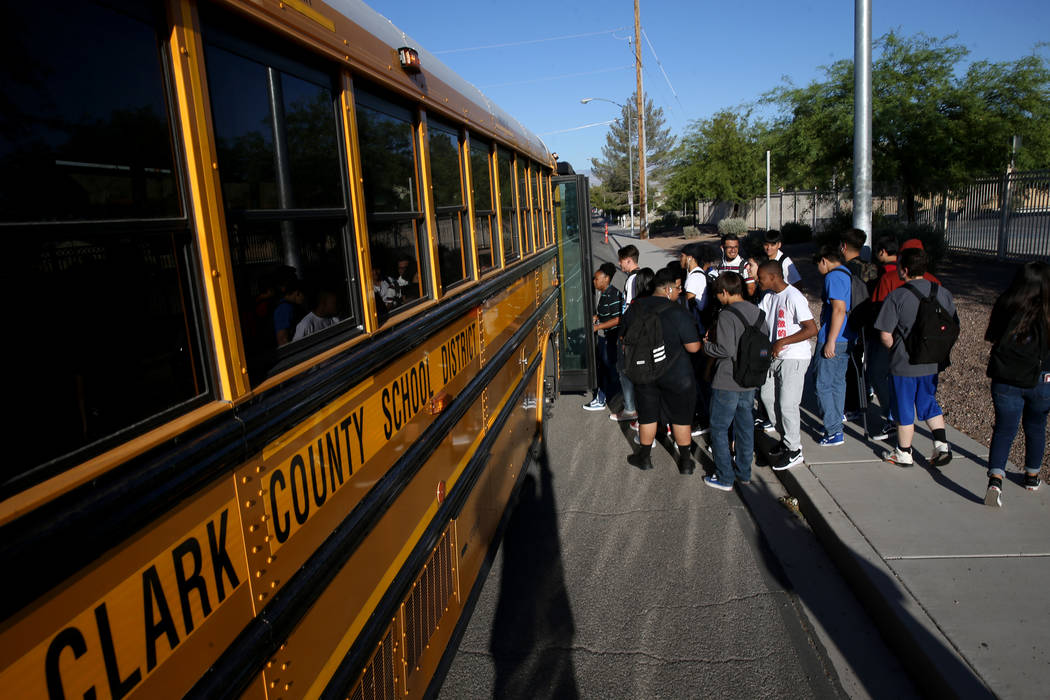Safety measures key for motorists, students in school zones

As 320,000 Clark County School District students head back to class this week, Las Vegas Valley motorists are urged to do their part to ensure those children arrive to and from school safely.
About 13 percent of students bike or walk to school, according to AAA, which reminds drivers and parents to be most cautious in the hours before, during and after school.
“Drivers have likely enjoyed the shorter commutes that typically come with summer break,” said Sergio Avila, AAA Nevada spokesperson. “Students have been staying home or enjoying a vacation with family. Back-to-school means it’s time for drivers to become more vigilant to avoid needless tragedies.”
The most dangerous time for students is between 3 p.m. and 7 p.m., AAA research revealed.
In March, 12-year-old Jonathan Smith was struck and killed by a vehicle as he and two other students crossed South Fort Apache Road near Arby Avenue outside of a crosswalk after school at Faiss Middle School. Clark County has since studied the area and will add a new traffic signal at the intersection, which bridges several neighborhoods and Faiss Middle School, Faiss Community Park and Wet ‘n’ Wild.
“Unfortunately last year we saw several examples of devastating instances involving school age children who were killed on their way to and from school,” said Andrew Bennett, Nevada Department of Public Safety spokesman. “Parents need to have the conversation with their children about traffic safety and everything they can do to stay safe.”
Motorists and students are reminded of the following safety rules:
School zone safety: Speed limits in school zones are reduced for safety reasons. Higher speeds increase the risk of serious crashes, so speed limits near schools are reduced to. Fines are double in school zones, so not only is speeding near a school dangerous, it could be costly as well. Additionally, U-turns in school zones are prohibited.
Bus safety: Drivers are required to stop for school buses when students are boarding and departing and when a bus is displaying its flashing red light.
On divided roads with a raised median or other physical barriers, traffic moving in the opposite direction of the bus does not have to stop. But as always, keep the safety of the students in mind and monitor the area for precautionary reasons before proceeding.
Students riding the bus to and from school are urged to utilize the SAFE procedure, according to the Nevada Department of Transportation:
-Stay five steps away from the curb.
-Always wait until the bus driver says its safe before boarding a bus.
-Face forward after taking a seat in a bus.
-Exit the bus when it stops, look to the left-right-left and take five steps away from the bus.
Bicycle safety: Drivers are cautioned to slow down and allow at least three feet of passing distance between their vehicle and a bicycle. As children on bikes are often inexperienced, unsteady and unpredictable, motorists should exercise extra caution while driving around school-aged children on bicycles.
Additionally, parents of children who ride bicycles to school, should provide safety tip and ensure their children are wearing a properly fitted bicycle helmet on every ride.
Crosswalk safety: Students and family members should cross roads only at designated crosswalks, adhering to all traffic signs, traffic signals and crossing guard instructions. A student who’s on a bike or scooter is asked to walk, not ride in the crosswalk.
Motorists are reminded that if they are parking on the side of a road near a crosswalk, they are to be 20 feet away from the crosswalk.
In addition, motorists are encouraged to eliminate distractions while they’re driving. Children often cross roads unexpectedly and may dart out from behind parked cars without warning. Drivers should be extra aware while driving near schools.
Motorists also should check for children on sidewalks, driveways, and around a vehicle before backing up. Although technology like reverse cameras and rear sensors increases comfort while reversing, it’s still vital to check one’s surroundings while reversing a vehicle.
“It’s imperative that all Nevadans are extra cautious during the first few weeks of school,” Bennett said. “Motorists can expect additional buses, vehicles, pedestrians and cyclists before and after school hours on our roadways.”